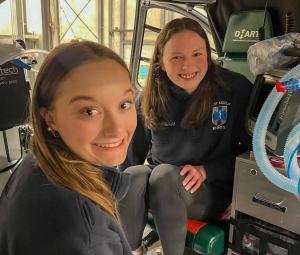Not only do Emergency Medical Technicians need to be effective communicators and able to make decisions in high stress situations, they also need to be caring and selfless. It is these kinds of qualities that the Saint Anselm College Emergency Medical Service (SACEMS) team embodies.
The EMS program here on campus was founded in 1991 and continues today. Two of the program's members, Megan Wozniak ’25 and Gabrielle Constantine ’24, were introduced to SACEMS during their freshman year, Meg through her advisor and Gabrielle through the club fair.
Both Wozniak and Constantine are nationally registered EMTs, meaning they finished an education program and took the NREMT exams. It takes around four months to complete the program. The program taught both the skills necessary to assess, stabilize, and transport patients. They are trained in CPR and bleeding control techniques, and can administer some medications. These medications include epinephrine, naloxone (NARCAN), and oxygen. After passing the EMT class and national exams to become NREMTs, Wozniak and Constantine became licensed in New Hampshire, which allows them to exercise their practices on campus safely.
“I knew that I wanted to explore a career in healthcare, so my advisor recommended I take the course to become an EMT,” said Wozniak. “Though it was sometimes challenging to balance the extra coursework, I completed the program with my national EMT certification. I joined the team shortly after I was licensed.”

Both students love being part of the program because of the tight-knit community and the knowledge that they can aid fellow students in need. Responding to 911 calls on campus is very fulfilling for Wozniak and Constantine as they take pride in providing support when needed. Often they stand-by at club sports games.
SACEMS is a very tight-knit group and their involvements on campus and sharing experiences cultivates relationships within the team. Currently, the team works weekends from 6 p.m. – 6 a.m. They aim to work two to three weekends a month. Responding to calls, attending weekly meetings, and traveling to the annual National Collegiate Emergency Medical Services conference together is a brief look into the EMS lifestyle.
But what of their future post-graduation? Wozniak says she is looking towards higher education. “I would like to attend medical school, or possibly join an MD-PhD program. These are ambitious goals, but my involvement with SACEMS has helped prepare me for the future.”
Constantine is currently working towards her BSN and will complete her preceptorship this summer in the Brigham and Women’s Emergency Department. “I am hoping to graduate next year and work in Emergency/Trauma Services before going for my flight nursing certification in the future!”
Wozniak and Constantine represent the collective excellence that SACEMS has shown for the last 22 years. In recent years, however, the number of students signing up for the SACEMS has dwindled, a concern to alum and current helicopter flight paramedic, Robert O’Donnell ’15. He completed the EMT program in his senior year of high school, serving on SACEMS during his time on the Hilltop. After graduation, O’Donnell entered the paramedic field. Over the next three years, he gained invaluable experience and knowledge as he worked half the years as a paramedic and spent the other half traveling the world. This unique dynamic helped polish and elevate O’Donnell’s resume, eventually landing him a position as a helicopter flight paramedic for Dartmouth-Hitchcock in 2021.
O’Donnell recognizes the impact SACEMS had on his life and his career path and is trying to find ways to increase the quantity of students in EMS.
